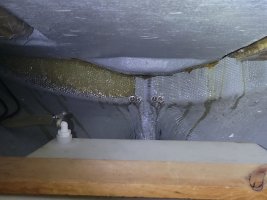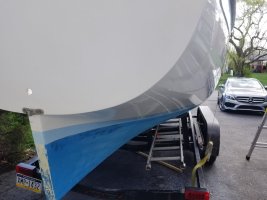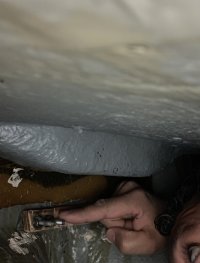My E25 lower rudder Gudgeon was pulled completely out when the rudder hit "something" :-(. The gudgeon was reattached by fine thread machine screws into a 1/4 inch aluminum backing plate that was glassed in. I know the original gudgeon was bolted through the hull. I had expected the gudgeon to be bolted and am a little concerned about the holding capacity of the 4 screws into aluminum. I don't need the new gudgeon to be attached stronger than the old one. I believe I can calculate the stripping strength of the screws (but any help would be appreciated), but I am not sure how I would compare that to the strength of the original assembly which I believe was 1/4 inch bolts and washers which were completely pulled through the hull. Thoughts?
You are using an out of date browser. It may not display this or other websites correctly.
You should upgrade or use an alternative browser.
You should upgrade or use an alternative browser.
Can you access the backing plate?
If so, the first way that comes to mind is just to redrill through transom and backing plate and reattach the gudgeon with bolts and nuts. Could be quarter inch or any bolts that seem appropriate. Bolts and nuts seem better for this than screws.
One part I don't quite understand--the original bolts and washers were completely pulled through the transom? And through the backing plate?
If so, the first way that comes to mind is just to redrill through transom and backing plate and reattach the gudgeon with bolts and nuts. Could be quarter inch or any bolts that seem appropriate. Bolts and nuts seem better for this than screws.
One part I don't quite understand--the original bolts and washers were completely pulled through the transom? And through the backing plate?
The original bolts and washers were completely pulled through the transom leaving 4 holes. There was not a backing plate originally. The washers were flat against the hull. (I had to buy a salvage Gudgeon from another E25 and they just cut it out of the hull so I know how it was set up. I don't have that piece with me right now but the hull was about an inch thick at that point. We were underway when this happened so we lost the Gudgeon).Can you access the backing plate?
If so, the first way that comes to mind is just to redrill through transom and backing plate and reattach the gudgeon with bolts and nuts. Could be quarter inch or any bolts that seem appropriate. Bolts and nuts seem better for this than screws.
One part I don't quite understand--the original bolts and washers were completely pulled through the transom? And through the backing plate?
The problem is I cannot easily access the backing plate. The boat yard cut a hole through the cockpit close to the transom to put the backing plate in. The plate is glassed in, and the hole in the cockpit is glassed in. There is no easy access to the transom under the deck unless you were very very small. I was expecting bolts like originally, and was surprised when I found out it was screws.
So I suspect to put in bolts you would need to recut the hole through the deck.....
It is kind of routine to cut in, carefully, an access plate for something like this. Beckson makes a 6" and also a 8" screw-out framed plate.So I suspect to put in bolts you would need to recut the hole through the deck.....
Screw-Out Deck Plate by Beckson
www.beckson.com
Nice buffing work on the hull!Just for reference, here is my E25 lower gudgeon. Was yours like this? I don't seem to have a pic of the lazarette area to see if I can see the backside of the transom there. I have taken the lazarette door and trim off to crawl back in there but it is narrow.
gabriel
Live free or die hard
Its not cavernous but there is enough room for a person of average stature to access the transom from below the cockpit. I’ve done it to install a plywood backing plate which I’m now wondering if it was a good idea:The original bolts and washers were completely pulled through the transom leaving 4 holes. There was not a backing plate originally. The washers were flat against the hull. (I had to buy a salvage Gudgeon from another E25 and they just cut it out of the hull so I know how it was set up. I don't have that piece with me right now but the hull was about an inch thick at that point. We were underway when this happened so we lost the Gudgeon).
The problem is I cannot easily access the backing plate. The boat yard cut a hole through the cockpit close to the transom to put the backing plate in. The plate is glassed in, and the hole in the cockpit is glassed in. There is no easy access to the transom under the deck unless you were very very small. I was expecting bolts like originally, and was surprised when I found out it was screws.
So I suspect to put in bolts you would need to recut the hole through the deck.....
The E25 CB rudder is vulnerable (especially with the centerboard up) and seeing what happened to you makes me want to go back to the idea of changing the 7/8 metal rudder pin for a breakaway fiberglass rod and attaching a lanyard.
was your centerboard raised or lowered when the rudder struck? Where were you sailing?
Last edited:
gabriel
Live free or die hard
Beautiful car.Just for reference, here is my E25 lower gudgeon. Was yours like this? I don't seem to have a pic of the lazarette area to see if I can see the backside of the transom there. I have taken the lazarette door and trim off to crawl back in there but it is narrow.
View attachment 41566
Last edited:
klb67pgh
Member III
Thanks. I was pretty proud of the result for my first ever effort. I also love the lines on the boat in this area, even though it means a bit less cockpit room than, say, a Catalina 25. Hence the pic. It snowed hard the next day on the day I intended to finish waxing the hull.Nice buffing work on the hull!
I'll see if I can get additional pics this weekend from the lazarette.
Yes it looks exactly like this, although when mine was replaced it was moved up about an inch......Just for reference, here is my E25 lower gudgeon. Was yours like this? I don't seem to have a pic of the lazarette area to see if I can see the backside of the transom there. I have taken the lazarette door and trim off to crawl back in there but it is narrow.
View attachment 41566
Centerboard was raised. We were motoring slowly through the Swinomish channel in the San Juan's on a very low tide (had completed about 10 3/4 miles of the 11 mile length :-(). I have gone through this channel before, but if I do this again on a low tide I think I would try to pull the rudder up as much as I could. The one bit of good news was that we were coming home and the weather was calm enough we could get the rudder off the remaining Gudgeon, temporarily plug the holes and motor back to Everett (while testing our bilge pumpIts not cavernous but there is enough room for a person of average stature to access the transom from below the cockpit. I’ve done it to install a plywood backing plate which I’m now wondering if it was a good idea:
The E25 CB rudder is vulnerable (especially with the centerboard up) and seeing what happened to you makes me want to go back to the idea of changing the 7/8 metal rudder pin for a breakaway fiberglass rod and attaching a lanyard.
was your centerboard raised or lowered when the rudder struck? Where were you sailing?
With respect to your backing plate, I think you may have a somewhat similar dilemma to me. This feels like a "math question". For me, I have 4 1/4 inch fine threaded screws that have been screwed into a 1/4 inch aluminum backing plate. There are 3 things I don't know:
1. What is the holding strength of those 4 screws?
2. How much pressure is applied by the rudder under normal operation to that lower Gudgeon?
3. What was the holding strength of the lower gudgeon in the original design, which just used 4 bolts and washers against the hull?
The similar issue we may have is that I do not want to actually pull the backing plate through the transom (or the transom "off") if something like this was ever to happen again. Four small holes is very preferable to that (and I wondered if this was part of the original design). As an aside, at one point a couple of years ago there was a guy in Idaho that built a "flip up" rudder for the E254, and there are threads in this forum that reference that.
Finally, good to know I might be able to reach the transom. I thought if I took the door off I might be able to get through the hole and even researched moving the water tank for the guy working on it....but he was not getting through the door.....
Based on my experience with dinghies, and with losing an outboard rudder on a 36-footer offshore, most of the force on the gudgeon is lateral, and continuous. It takes hitting something to yank the bolts. More often they loosen first and fail that way.
I think if it were me, in this case I'd consider putting it back the way it was--new machine screws tapped into the aluminum backing plate. Secure, but probable point of failure in any nasty grounding.
The rudder is vulnerable, and I think I'd prefer the gudgeon to fail before something else.
Just a comment.
I think if it were me, in this case I'd consider putting it back the way it was--new machine screws tapped into the aluminum backing plate. Secure, but probable point of failure in any nasty grounding.
The rudder is vulnerable, and I think I'd prefer the gudgeon to fail before something else.
Just a comment.
gabriel
Live free or die hard
Wow, thanks for sharing that. that answers many questions I had about the rudder striking something. unfortunately it had to come at your costCenterboard was raised. We were motoring slowly through the Swinomish channel in the San Juan's on a very low tide (had completed about 10 3/4 miles of the 11 mile length :-(). I have gone through this channel before, but if I do this again on a low tide I think I would try to pull the rudder up as much as I could. The one bit of good news was that we were coming home and the weather was calm enough we could get the rudder off the remaining Gudgeon, temporarily plug the holes and motor back to Everett (while testing our bilge pump). Also interestingly the rudder was not hurt by whatever we hit (the steel rudder pin was bent and the rudder did get pretty gouged by the prop...)
With respect to your backing plate, I think you may have a somewhat similar dilemma to me. This feels like a "math question". For me, I have 4 1/4 inch fine threaded screws that have been screwed into a 1/4 inch aluminum backing plate. There are 3 things I don't know:
1. What is the holding strength of those 4 screws?
2. How much pressure is applied by the rudder under normal operation to that lower Gudgeon?
3. What was the holding strength of the lower gudgeon in the original design, which just used 4 bolts and washers against the hull?
The similar issue we may have is that I do not want to actually pull the backing plate through the transom (or the transom "off") if something like this was ever to happen again. Four small holes is very preferable to that (and I wondered if this was part of the original design). As an aside, at one point a couple of years ago there was a guy in Idaho that built a "flip up" rudder for the E254, and there are threads in this forum that reference that.
Finally, good to know I might be able to reach the transom. I thought if I took the door off I might be able to get through the hole and even researched moving the water tank for the guy working on it....but he was not getting through the door....., so we dropped that approach....
In a way it just shows how Ericson knew what they were doing…the original design seemed wimpy but this was done purposely to give way in the event of a strike. It’s easier to repair 4 holes than a broken rudder!
klb67pgh
Member III
I finally had time to get to my boat storage garage and take a picture. It looks like lock nuts and an oversize washer on each machine screw. Someone on the tall and skinny side would be needed to reach them. Or about 6 feet of ratchet extensions. I don't know if this is as installed by the factory - i suspect so. The water tank has the factory install date written on it and does not look like it was disturbed. 

Blue Streak
E25
That is a great shot of how a hull should look.Just for reference, here is my E25 lower gudgeon. Was yours like this? I don't seem to have a pic of the lazarette area to see if I can see the backside of the transom there. I have taken the lazarette door and trim off to crawl back in there but it is narrow.
View attachment 41566
Last edited:


